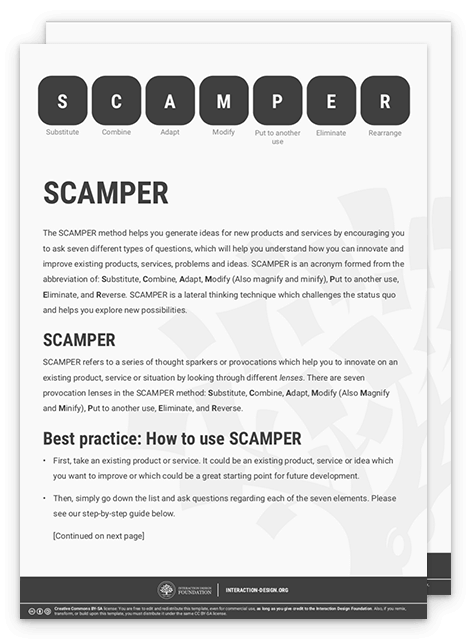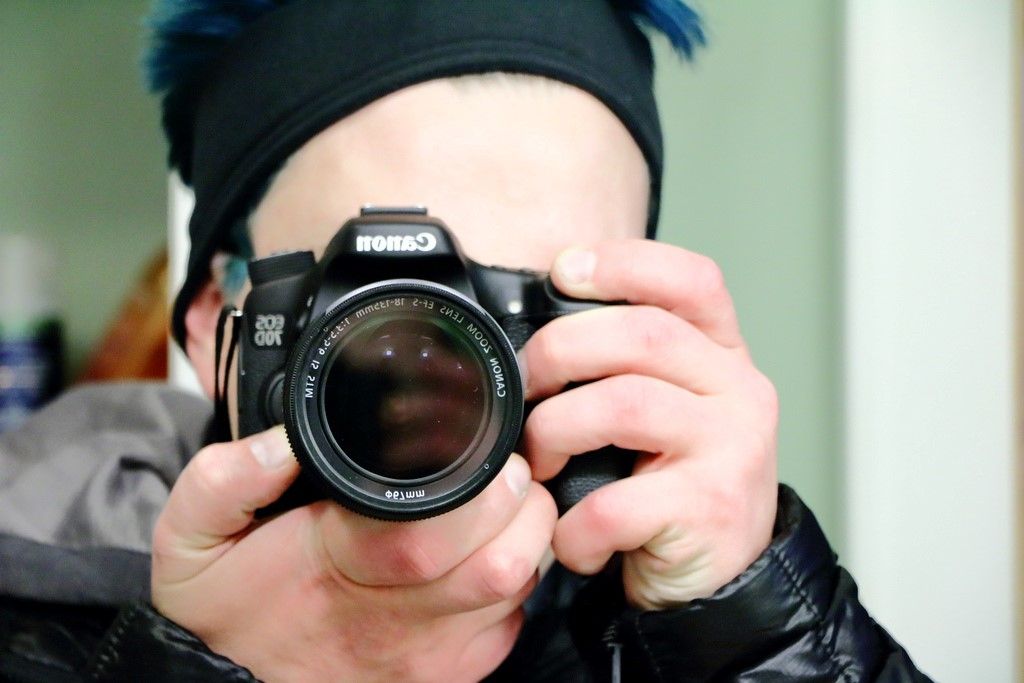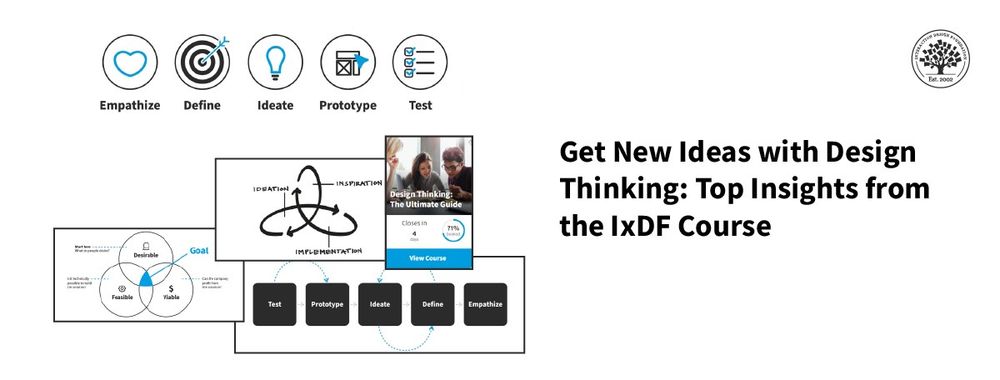The SCAMPER method helps you generate ideas for new products and services by encouraging you to ask seven different types of questions, which will help you understand how you can innovate and improve existing products, services, problems and ideas. Here, you’ll learn how to use the method. SCAMPER is surprisingly easy to start using and very efficient in innovation and ideations sessions.
SCAMPER Method
SCAMPER refers to a series of thought sparkers or provocations which help you to innovate on an existing product, service or situation by looking through different lenses. There are seven provocation lenses in the SCAMPER method:
Substitute
Combine
Adapt
Modify (Also Magnify and Minify)
Put to another use
Eliminate
Rearrange
How to Use SCAMPER
First, take an existing product or service. It could be an existing product, service or idea which you want to improve or which could be a great starting point for future development.
Then, simply go down the list and ask questions regarding each of the seven elements. Please see our step-by-step guide below.
Apply the questions to values, benefits, services, touch points, product attributes, pricing, markets and essentially any other related aspect you might be able to think of that has relevance to your ideation needs.
Look at the answers that you came up with. Do any of the answers stand out as viable solutions? Could you use any of them to create a new product, or develop an existing one?
Take the good ideas and explore them further.
Example – McDonald’s
 Author/Copyright holder: rob_rob2001 . Copyright terms and licence: CC BY-SA 2.0
Author/Copyright holder: rob_rob2001 . Copyright terms and licence: CC BY-SA 2.0
McDonald’s would come to be a larger-than-life household name; it may seem hard to see in the 21st century, but the philosophy behind its ‘formula’ revolutionised the old style of restaurant experience.
Take, for example, McDonald’s founder, Ray Kroc. As he’s already done all the hard work, it’s now easy for us to identify some of the ideas he used in the SCAMPER method:
Put to other uses: Selling restaurants and real estate instead of just simply hamburgers.
Eliminate: Letting customers serve themselves and thereby avoiding the use of expensive waiters.
Rearrange: Having customers pay before they eat.
Step-by-step Guide
Substitute
 Author/Copyright holder: Teo Yu Siang and Interaction Design Foundation. Copyright terms and licence: CC BY-NC-SA 3.0
Author/Copyright holder: Teo Yu Siang and Interaction Design Foundation. Copyright terms and licence: CC BY-NC-SA 3.0
Overall, the question to think about here is this: What can I substitute or change in my product, problem or process? You should think about substituting part(s) of your product or process for something else.
Guiding questions:
What can I substitute so as to make an improvement?
How can I substitute the place, time, materials or people?
Can I substitute one part for another or change any parts?
Can I replace someone involved?
Can I change the rules?
Should I change the name?
Can I use other ingredients or materials?
Can I use other processes or procedures?
Can I change its shape, colour, roughness, sound or smell?
Can I use this idea for other projects?
Can I change my feelings or attitude towards it?
Use these instead of starting with: ‘I can ...’
Combine
 Author/Copyright holder: Teo Yu Siang and Interaction Design Foundation. Copyright terms and licence: CC BY-NC-SA 3.0
Author/Copyright holder: Teo Yu Siang and Interaction Design Foundation. Copyright terms and licence: CC BY-NC-SA 3.0
The overall question to think about here is: How can I combine two or more parts of my product, problem, or process so as to achieve a different product, problem, or process to enhance synergy? Creative thinking involves combining previously unrelated ideas, products, or services in order to create something new and innovative.
Guiding questions:
What ideas, materials, features, processes, people, products, or components can I combine?
Can I combine or merge this or that with other objects?
What can I combine so as to maximize the number of uses?
What can I combine in order to lower the costs of production?
Which materials could I combine?
Where can I build synergy?
Which are the best elements I can bring together so as to achieve a particular result?
Adapt
 Author/Copyright holder: Teo Yu Siang and Interaction Design Foundation. Copyright terms and licence: CC BY-NC-SA 3.0
Author/Copyright holder: Teo Yu Siang and Interaction Design Foundation. Copyright terms and licence: CC BY-NC-SA 3.0
Overall, the question you need to think about is: What can I adapt in my product, problem, or process? Think about which parts of the product or process you could adapt so as to solve your problem.
Guiding questions:
Which part of the product could I change?
Could I change the characteristics of a component?
Can I seek inspiration in other products or processes, but in a different context?
Does the history offer any solutions?
Which ideas could I adapt, copy, or borrow from other people’s products?
What processes should I adapt?
Can I adapt the context or target group?
What can I adapt in this or that way in order to make this result?
Modify (Also Magnify and Minify)
 Author/Copyright holder: Teo Yu Siang and Interaction Design Foundation. Copyright terms and licence: CC BY-NC-SA 3.0
Author/Copyright holder: Teo Yu Siang and Interaction Design Foundation. Copyright terms and licence: CC BY-NC-SA 3.0
Overall, the question you need to focus on is this: What can I modify or put more or less emphasis on in my product, problem, or process? Can I change the item in some way? Can I change meaning, colour, motion, sound, smell, form, or shape? It’s time to magnify or exaggerate your idea, product, problem, or process—or to minify it. These questions will give you new insights about which components are the most important ones. Think about changing part or all of the current situation or product. Alternatively, distort the product in an unusual way.
Guiding questions:
What can I magnify or make larger?
What can I tone down or delete?
Could I exaggerate or overstate buttons, colours, size…?
Could I grow the target group?
What can be made higher, bigger, or stronger?
Can I increase its speed or frequency?
Can I add extra features?
How can I add extra value?
What can you remove or make smaller, condensed, lower, shorter or lighter—or streamline, split up or understate?
What can I change in this way or that way so as to achieve such and such a result?
Put to Another Use
 Author/Copyright holder: Teo Yu Siang and Interaction Design Foundation. Copyright terms and licence: CC BY-NC-SA 3.0
Author/Copyright holder: Teo Yu Siang and Interaction Design Foundation. Copyright terms and licence: CC BY-NC-SA 3.0
The overall question to consider here is this: How can I put the thing to other uses? What are new ways to use the product or service? Can I reach out to other users if I modify the product? Is there another market for the product? It’s time to work out how you may be able to put your current product or idea to other uses and purposes.
Guiding questions:
What else can it be used for?
How would a child use it?—an older person?
How would people with different disabilities use it?
Which other target group could benefit from this product?
What other kind of user would need or want my product?
Who or what else may be able to use it?
Can it be used by people other than those it was originally intended for?
Are there new ways to use it in its current shape or form?
Would there be other possible uses if I were to modify the product?
How can I reuse something in a certain way by doing what to it?
Eliminate
 Author/Copyright holder: Teo Yu Siang and Interaction Design Foundation. Copyright terms and licence: CC BY-NC-SA 3.0
Author/Copyright holder: Teo Yu Siang and Interaction Design Foundation. Copyright terms and licence: CC BY-NC-SA 3.0
Your overall question to consider here is: What can I eliminate or simplify in my product, design, or service? Think of what might happen if you were to eliminate, simplify, reduce, or minimise parts of your idea. If you continue to trim your idea, service, or process—you can gradually narrow your challenge down to that part or function that is most important.
Guiding questions:
What can I remove without altering its function?
Can I reduce time or components?
What would happen if I removed a component or part of it?
Can I reduce effort?
Can I cut costs?
How can I simplify it?
What’s non-essential or unnecessary?
Can I eliminate the rules?
Can I make it smaller?
Can I split my product into different parts?
I can eliminate what by doing what?
Rearrange
 Author/Copyright holder: Teo Yu Siang and Interaction Design Foundation. Copyright terms and licence: CC BY-NC-SA 3.0
Author/Copyright holder: Teo Yu Siang and Interaction Design Foundation. Copyright terms and licence: CC BY-NC-SA 3.0
Overall, you have to ask yourself this question: How can I change, reorder, or reverse the product or problem? What would I do if I had to do this process in reverse?
Guiding questions:
What can I rearrange in some way – can I interchange components, the pattern, or the layout?
Can I change the pace or schedule?
What would I do if part of your problem, product or process worked in reverse?
I can rearrange what in what way such that this happens?
Historical Background
Alex Osborn, the originator of the brainstorming method, originally came up with many of the questions used in the SCAMPER technique. However, it was Bob Eberle, an education administrator and author, who organised these questions into the SCAMPER mnemonic.
The Take Away
The SCAMPER method helps you generate ideas for new products and services by encouraging you to ask seven different types of questions, which will help you understand how you can innovate and improve existing products, services, problems and ideas. SCAMPER is an acronym formed from the abbreviation of: Substitute, Combine, Adapt, Modify (Also magnify and minify), Put to another use , Eliminate, and Reverse. SCAMPER is a lateral thinking technique which challenges the status quo and helps you explore new possibilities.
You can download and print the template where we’ve described the best practice for the SCAMPER method:


References & Where to Learn More
Hero Image: Author/Copyright holder: Damgood AVLien. Copyright terms and licence: CC BY-SA 2.0
SCAMPER – Improving Products and Services.
Luciano Passuello, Creative Problem Solving with SCAMPER




